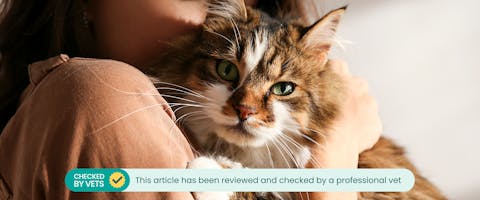Updated 22/05/2023
With National Pet Obesity Awareness Day approaching on 9th October, we’re reminded that weight gain in pets is a very real issue. With studies by The Association for Pet Obesity Prevention in 2021 stating that over half of all dogs and cats are classed as obese, there’s no better time to assess how healthy your cat’s weight is and kick-start their healthy future.
1. Speak to your vet
There can be a number of reasons why your cat may be on the heavier side; from their age to neighbors who can’t resist supplying them with extra supper. First things first, it’s best to take them to the vet to rule out any undiagnosed medical conditions — such as fluid retention— and for information on a diet plan that’s best for your cat, such as a daily calorie allowance, advice on specialist diet foods and goal weight.
Trending posts
Purr-use some of the top blogs our members have been loving this month- Top male dog names for your new furry friendGot a new furry family member in your pack? Check…

- Top female dog names for your new fluffy palWelcoming a new pooch into your family? Explore…

- 250+ gray cat names your silver feline will loveRecently welcomed a fluffy gray bundle of joy into…

- What are normal pet sitting rates?Discover the average pet sitting rates for animals…

- Unique dog names to stand out from the packDare to be different with our list of the best…

2. Resist giving them treats
It’s important to focus on everything your cat is eating in order for them to lose weight. It sounds simple, but it’s very easy to forget little scraps of food leftover from dinner or supermarket-brought cat treats given to them throughout the day, but it all adds up to extra calories for your cat. So check in with what you give them, and if you do want to show them affection through the odd treat, ensure it’s calculated within their daily calorie allowance. Remember, because cats are so much smaller than us, what we might see as a small tidbit can actually be quite calorific to a cat.
3. Make sure everyone knows they’re on a diet
If your cat is going to successfully shift any extra weight, you need to make sure everyone your cat interacts with is aware that they’re on a restricted diet. Whether it’s your family, neighbor, or your sitter, they need to know that your kitty shouldn’t have any extra nibbles! If they wear a collar, having a tag which asks them not to be fed can be helpful.
4. Play with them
Cats tend to exercise in small bursts, and so regular – but short – periods of playtime could really make the difference when it comes to their weight. This is particularly important if they are an indoor cat, as the space they have to roam is smaller than that of an outdoor cat. Invest in some toys and aim to get your kitty moving for up to thirty minutes throughout the day — you can break this up into smaller periods to cater to your cat's preferred playtime. Laser pens, balls or even a simple piece of string will work to get your cat moving!
5. Change their usual eating spot
In the kitchen, by the back door, or the hallway; wherever it is that your cat is used to finding their food at certain times of the day, set them the challenge of searching for their food by switching up their normal eating spot so that they have to seek out or ‘hunt’ for their food. Puzzle feeders and treat balls can also slow your cat’s eating and help them feel more satisfied.
Trusted tip: if you have more than one cat, or are caring for a multi-cat household, then feeding them separately may be something you wish to consider to avoid any chance of the overweight kitty stealing from their fellow felines!
Meet our veterinary expert, Lizzie
This article has been checked by veterinarian Lizzie Youens BSc (Hons) BVSc MRCVS. Lizzie graduated from the University of Bristol in 2011, and has been working in first opinion companion animal practice. She has worked in a variety of clinics across the UK, from large hospitals to small branch practices. She enjoys doing a mixture of medicine, surgery and emergency work. Lizzie currently works in a small rural practice where she enjoys working in a close-knit community.
Remember, whatever method you use to encourage your cat’s weight loss, be sure to take them for regular checkups with your vet so you can check in on their progress to ensure your cat is on the right track to a healthy weight and a longer, happier life.

